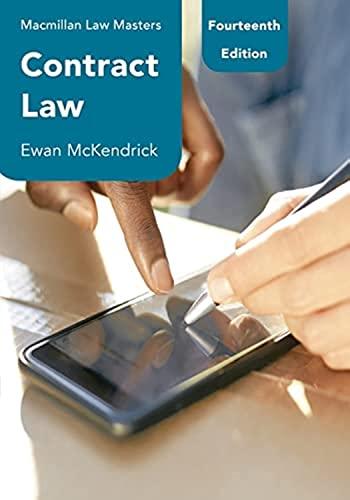Question
EXAM: 1. Describe a search incident to a pretext arrest and explain its significance. Reference Chapter 6: Searches for Evidence The following questions (2a,
EXAM:
1. Describe a search incident to a pretext arrest and explain its significance.
Reference Chapter 6: "Searches for Evidence"
The following questions (2a, 2b and 2c) reference Chapter 7 ( "Special Needs Searches)
~~~~~~
2a. Why are inventory searches reasonable without warrants or probable cause?
2b. Identify the special needs satisfied by inventory searches
2c. What substitutes for probable cause are available as the objective basis for inventory searches?
~~~~~~~
3. Why don't searches of probationers and parolees require warrants or probable cause to be reasonable?
Reference: Chapter 7 ( "Special Needs Searches)
4. Identify the three provisions in the U.S. Constitution that govern police interrogations and confessions.
Reference: Chapter 8 ( Self-Incrimination)
~~~~~~
The following questions (5a, 5b and 5c) reference Chapter 8 ( Self-Incrimination):
5a. State the reasons for the bright-line rule regarding warnings to suspects adopted in Miranda v. Arizona.
5b. Identify two circumstances that must be present before officers are required to give the Mirandawarnings.
5c. List three types of questioning when officers do NOT have to give the Mirandawarnings.
~~~~~~~
The following questions (6a and 6b) reference Chapter 9 ( "Identification Procedures"):
6a. Identify the two steps in the totality of circumstances due process test of admissibility of eyewitness identification created by the U.S. Supreme Court.
6b. Identify and describe the five (5) circumstances in the totality of circumstances due process test(s) you identified.
~~~~~~~
7. Identify and explain the rationales behind the three justifications for the exclusionary rule.
Reference: Chapter 10: "Remedies for Constitutional Violations I: The Exclusionary Rule"
8. List and explain the five (5) exceptions to the exclusionary rule.
Reference: Chapter 10: "Constitutional Violations I: Remedies for Constitutional Violations I: The Exclusionary Rule"
9. Identify the two elements of qualified immunity defense, and explain why the test is so easy for officers to pass.
(per our textbook: Criminal Procedure10 thedition by author Joel Samaha when published in 2018)
Reference Chapter 11: "Constitutional Violations II: Other Remedies Against Official Misconduct."
10. Can you sue a judge or prosecutor for damages resulting from actions performed in theirofficial capacities? Explain.
Reference Chapter 11: "Constitutional Violations II: Other Remedies Against Official Misconduct."
Step by Step Solution
There are 3 Steps involved in it
Step: 1

Get Instant Access to Expert-Tailored Solutions
See step-by-step solutions with expert insights and AI powered tools for academic success
Step: 2

Step: 3

Ace Your Homework with AI
Get the answers you need in no time with our AI-driven, step-by-step assistance
Get Started


